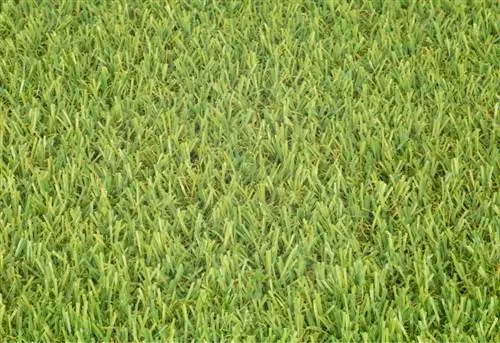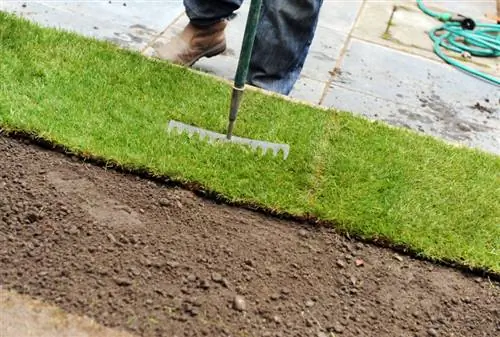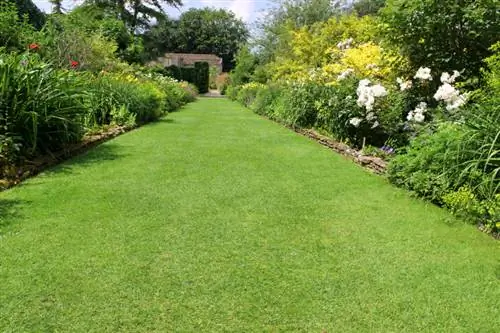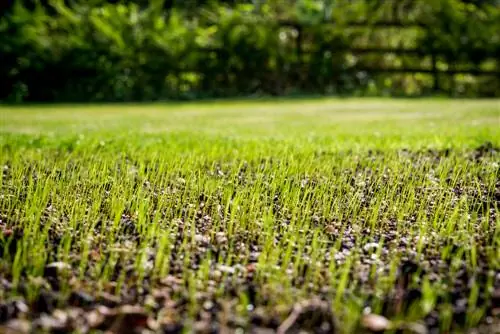- Author admin [email protected].
- Public 2023-12-16 16:46.
- Last modified 2025-01-23 11:20.
After winter, the lawn has a battered appearance. It's high time for professional lawn care. You can find out here which fitness program around the first lawn cut in spring will transform the stubble meadow into a velvet green carpet.
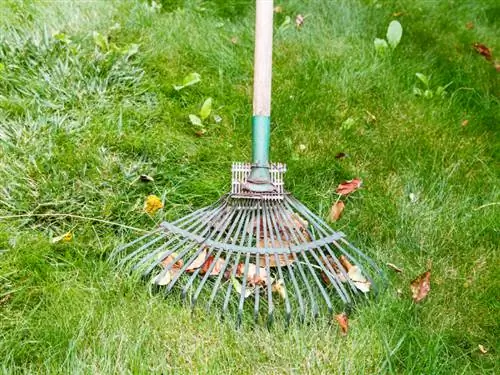
How do I properly care for my lawn in spring?
Spring lawn care includes removing leaves, repairing gaps, sharpening the lawn mower, the first lawn cut at a cutting height of 3-4 cm, scarifying if necessary, liming, and fertilizing with organic lawn fertilizer. Pay attention to favorable weather conditions and rest periods for mowing.
Careful preparation simplifies care
During the cold season, tangles, moss and discolored areas dominate the lawn. The cause is high snow pressure and constant wetness, which affects the blades of grass over a long period of time. In addition, all sorts of plant remains that were blown in by the cold wind have accumulated. It is therefore important to prepare the stressed grass area after winter. These measures are recommended in February:
- Use a fan broom (€15.00 on Amazon) or rake to sweep up all leaves and other plant residues and dispose of them in the compost
- Then lightly sweep over it with the street broom to loosen any stuck parts of the lawn
- Rake noticeable holes in the lawn with a little compost and sand to close them
February is also the best time to take the lawn mower out of its winter quarters. If you take the knives to a specialist workshop to be sharpened, you won't have to worry about having a dull cutting mechanism the first time you cut your lawn in the spring. Skilled hobby gardeners sharpen their lawnmower blades themselves in February.
When is the best time for the first lawn cut in spring?
Among hobby gardeners there is always uncertainty about the right time to cut the lawn for the first time in spring. The following signals indicate the ideal date in March:
- The temperatures no longer fall below 10 degrees Celsius at night
- Early bloomers, such as daffodils, indicate the end of the winter growth break
- The blades of grass have reached a height of about 8 centimeters
- The weather is overcast and mild, without any rain
- The lawn is as dry as possible
If you want quantitative proof, add up all mean temperatures above 0 degrees Celsius from January. If these add up to more than 180 degrees, spring lawn care can begin. This value is usually reached in March.
How to mow the lawn correctly
If all the requirements have been met to your satisfaction, the mower is used for the first lawn cut in the spring. Set the device to a cutting depth of 3-4 centimeters. If the lawn has grown higher than 8 centimeters, mow in two stages, first to 6 centimeters and then to 3 centimeters. Ideally, you should not step on the unmown lawn.
Paying attention to the time keeps the neighborhood peaceful
Prudent hobby gardeners make sure not to mow during the legally required rest periods when cutting the lawn for the first time in spring. The times 9 a.m. to 1 p.m. and 3 p.m. to 5 p.m. only apply to motorized lawn mowers. Quiet lawn mowers with the EU eco-label have a green light from 7 a.m. to 8 p.m. On Sundays and public holidays, the lawn may best be trimmed with a hand mower.
Dethatching allows the lawn to breathe a sigh of relief - here's how it works
After the first lawn cut in spring, experienced hobby gardeners take a look at the grass area. If moss, thatch and weeds block the air from the stalks, targeted scarification is the next point in the care protocol. All unwanted plant parts are combed out using a special device. In March or April follow these steps:
- The freshly mown lawn is dry, but not dried up
- In the first step, set to a working depth of 3 mm, which is only increased if necessary
- First go quickly over the area with the scarifier in the lengthwise direction
- Work a heavily weedy area in the transverse direction in the second pass
Do not stand still while scarifying, otherwise the rotating blades will dig too deep into the turf. Only opt for this component of lawn care after winter when weeds and moss dominate. However, if he althy grass predominates, a sufficient supply of nutrients is sufficient for vital and dense growth.
Tip
With a simple trick, you can automatically aerate your lawn every time you mow. To do this, simply strap lawn aerator sandals under your work shoes. The robust sandals are equipped with 5 centimeter long soil nails that supply the turf with oxygen with every step.
Liming in March keeps moss in check - here's how to do it right
The be-all and end-all of a vital, deep green carpet of lawn is the correct pH value of the soil, which is 6-7. If the value is below this, more mosses thrive in acidic soil than blades of grass. An uncomplicated test from the garden center shows whether the pH value can be regulated using lime. The following table gives proven guidelines for the dosage of lawn lime:
| Guide values for lime per square meter of lawn | Light soil with lots of sand | Medium soil with clay and sand | Heavy soil made of loam and clay |
|---|---|---|---|
| pH value below 5 | 150-200 grams | 300-400 grams | 350-450 grams |
| pH value 5-6 | 120-180 grams | 180-250 grams | 250-350 grams |
| pH value 6-7 | do not lime | do not lime | do not lime |
| pH value above 7 | do not lime | do not lime | do not lime |
Immediately after scarifying in March, lime is applied as the aerated lawn can now optimally utilize the active ingredient.
How to properly fertilize the lawn after winter
Adequate nutrient supply goes hand in hand with the first lawn cutting in spring and scarifying. Experienced hobby gardeners allow 3-4 weeks to pass after liming before applying the lawn fertilizer.
Environmentally conscious hobby gardeners do not use mineral fertilizer because it is quickly washed out and pollutes the groundwater with nitrates. Organic fertilizers are more sustainable and long-lasting and promote the growth and vitality of the lawn. Plant manure made from nettles or comfrey works wonders here. In addition to the NPK fertilizers, a number of biological preparations can also be found in specialist retailers. How to do it right:
- Apply fertilizer granules preferably with a spreader
- Water the lawn repeatedly
- Spread liquid fertilizer with the pressure sprayer
- Avoid overlapping applications if possible
- Don't mow again until all the fertilizer grains have been rained on
Tips & Tricks
Mowing the lawn and of course fertilizing it can now be done in one step. The new lawn mower with mulching function shreds the clippings into the smallest particles that remain between the blades of grass. This eliminates the need for annoying and laborious disposal. At the same time, the lawn is regularly supplied with fresh nutrients and shines in a lush green.


